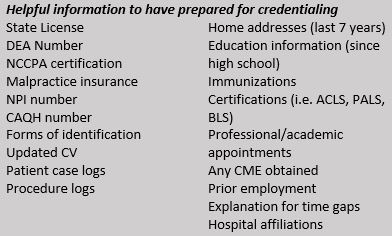What They Didn’t Tell Me in PA School: Five Months to Start Working
New Grad Shares Her Experience
September 9, 2019
By Hillary Bennett, PA-C

I was so excited to graduate from PA school at the University of Oklahoma Health Sciences Center in Oklahoma City, Oklahoma. I’d made it through didactic year, I’d made it through rotations, and I’d made it past the PANCE. I was ecstatic to get my first job as a PA.
I knew I wanted to practice in acute/critical care, and I began my job search approximately one month before graduating from PA school. I applied to every job listing and followed every referral even remotely related to acute/critical care. Many applications disappeared into oblivion, with no employer responses. Some employers responded to say that the position was filled, or that they do not accept new graduates. I was only offered a few interviews. The interview process varied from position to position. Some employers required me to interview in front of a panel of stakeholders, while others asked me to participate in multiple interviews over several weeks.
Perfect Job
I was feeling frustrated when I received an email from a PA school professor about a trauma critical care position. As soon as I could, I emailed my CV and expressed my interest in the position and requested to discuss the opportunity in person. A few days later, I met with my future employer, coworker, and mentor. The conversation was casual, very different from the interviews I’d been a part of before. I was immediately at ease and we discussed the position, current PA issues, my education, and my aspirations. She informed me that she would be meeting with a couple of other PAs interested in the position, and would get back to me. One month after graduating PA school, I received the glorious email: I got offered the position! I knew it would be a perfect fit for me. I liked that I’d be working in a critical care position, I felt like I’d hit it off with my future coworkers, and I really liked that I would be employed by a fellow PA and joining a PA group, working side-by-side with my employers, learning from their experience.
[PA Like a Pro: A webinar series just for PA students and early career PAs]
The Waiting Begins
I had received the perfect job offer, but I couldn’t start working yet. I had to deal with a lot of red tape, some of which I was expecting, and some of which I was not. First, I needed to finalize my state license. This entailed establishing a collaborating physician and getting signatures from all of the physicians I would be working with – most of whom I’d never met! Once my state license was issued, I next needed to obtain a DEA number. But wait! I actually needed an Oklahoma Bureau of Narcotics and Dangerous Drugs (OBNDD) number before I could apply for a DEA number. I got my OBNDD number and subsequently my DEA number, but that was an unanticipated speed bump.
 Hospital Credentialing
Hospital Credentialing
Next, I needed to get my hospital credentials. Luckily, my employer could help me with this. It was a two-part process. First, it was my job to gather all the information they needed. Once I submitted everything, I then needed to wait on others to verify my information and provide my credentials.
The PA group – my future coworkers – really helped me during this time. They led communication with hospital credentialing staff and supported me through the course. The hospital requested massive amounts of information. I anticipated some of these requests, such as state license, DEA, OBNDD, and NCCPA certification. But other requests I wasn’t as prepared for: background checks, immunization records, forms of identification, and certifications (i.e. ACLS, BLS, PALs). Some requests you actually can’t complete yourself: I needed to obtain malpractice insurance, and I needed peer reviews. My employers really helped me with these items.
This was a lot of information to keep handy – and organized – and I found PA Portfolio really helpful during this process. After I submitted all of this information, the timeline was completely out of my hands. I just had to wait for the hospital to verify everything I had submitted. My wait seemed interminable: it was delayed by both end-of-year leave and a government shutdown! Once my information was finally confirmed, I still had to wait for my application to be presented to the hospital medical board, which only meets once a month. Finally, finally, my application was approved and I could begin work!
[Get yourself organized with PA Portfolio.]
The Realities of the Wait
This story obviously ends happily, but I had some real stress during this five-month process. There I was, a newly graduated PA, with a job offer, but no way to work in my chosen profession until the bureaucratic knots had been untangled. I knew I needed to be patient, but I also wasn’t working any hours, so I wasn’t making any money. I patiently waited three months and then received a phone call informing me that my hospital credentialing could take an additional 90 days. Stress really kicked in at this point.
My student loan disbursement was dwindling, my bills were growing, and I could be 90 days away from working? I was desperate. I started questioning whether or not I should have settled for that clinic job, because at least by now I’d be earning a paycheck. I was worried I wasn’t going to make ends meet, but I also knew I’d found my dream job. I decided to do whatever it took to wait out this never-ending process.
I developed a strict budget. I cancelled or froze any non-essential expenses (streaming, meal delivery, gym, etc.), completely avoided the tempting locations of Amazon and Target, and began hunting for non-commitment financial opportunities. These jobs varied from cleaning bathrooms at my local church to teaching classes at my undergraduate university. Many of my side hustles came from “work on your own time” apps, such as babysitting, food delivery, dog walking, and ridesharing. I also used shopping rebate apps, in order to make a little bit of money back after grocery shopping. I even organized my closet and sold clothes and unused items on various resale apps.
Another way I made money? I sewed! Honestly, it’s a skill I’d almost forgotten about, but I made and sold several quilts for Christmas gifts.
Five months later
On March 4, 2019, at 6:00 a.m., I finally walked into the Trauma Intensive Care Unit and begin practicing as a PA.
While the wait was torturous, I feel so lucky to work as a PA. Every morning I get the opportunity to go to work, and I have a hand in the healing of extremely sick and hurt people. It is a privilege to guide families and patients through traumatic experiences, while practicing to the best of my abilities and education.
Not every credentialing process is identical, nor will it fall into a single standard timeline. For example, some hospitals may grant temporary privileges within 24 hours, where others may take weeks or months (like mine!). As a new graduate, you can expect to wait a little longer compared to your experienced colleagues.
My advice to all new PA graduates is this: start early! Have a plan and get someone in your corner to help you. Whether that’s your employer, a PA program faculty member, a seasoned PA, or a mentor, having someone to talk to and answer your questions is really helpful. I hope that my story might be helpful to other PA students and new graduates because I was really surprised it took five months to be able to start working. It took a lot of patience, and a lot of coordination, but I can say, without a doubt, becoming a PA was the best decision I ever made.
Additional Resources
PA Portfolio – Online Storing and Sharing
AAPA’s Career Central
PA JobSource
Hillary Bennett, PA-C, practices trauma critical care at Wesley Medical Center in Wichita, Kansas. She can be reached at [email protected]. She is a member of AAPA’s Early Career PA Commission and an Oklahoma delegate in AAPA’s House of Delegates.
Thank you for reading AAPA’s News Central
You have 2 articles left this month. Create a free account to read more stories, or become a member for more access to exclusive benefits! Already have an account? Log in.



